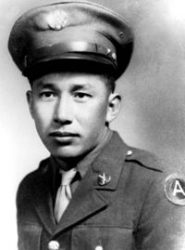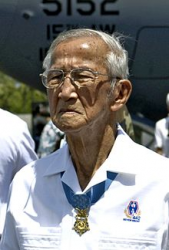
 |
|
|
||
|
Barney Fushimi Hajiro |
||||
|
Engagements: • World War II (1941 - 1945) |
||||
| Biography: | ||||
|
Barney Fushimi Hajiro Private First Class Barney Fushimi Hajiro (16 September 1916 - 21 January 2011) was a U.S. Army soldier and a recipient of the U.S. military's highest award for valor, the Medal of Honor, for his heroic actions during World War II. Barney Fushimi Hajiro was born in Puunene on the island of Maui, the eldest of nine children born to Japanese immigrant parents who had moved from Hiroshima to Maui during World War I. Two of his siblings died in infancy. The family was poor, and Hajiro left school to work, first in the sugarcane fields of Maui and later as a stevedore in Honolulu. Shortly after the Japanese attack on Pearl Harbor, he was drafted into the U.S. Army and performed menial labor as part of an engineering battalion. He resented not being allowed to carry arms. "I didn't bomb Pearl Harbor," Mr. Hajiro said in an interview in 1999. "Why did they blame us?" As angry about the attack on Pearl Harbor as anybody, many Japanese-Hawaiians were eager to fight. Hajiro was one of the first to volunteer, in March 1943. In March 1943, he volunteered to join the newly-formed 442nd Regimental Combat Team, composed of Nisei (second-generation Japanese Americans) like himself (below the officer ranks). The 442nd's motto, "Go for Broke' was epitomized by Hajiro. The unit was sent to Europe and in May 1944 fought the Germans in Italy, north of Rome. From there the 442nd was redeployed to France, and on 19 October 1944 was fighting near Bruyères and Biffontaine in the eastern part of that country. Over the next ten days, Hajiro, a Private in Company I, repeatedly distinguished himself in battle. He exposed himself to enemy fire while assisting an allied attack on 19 October, and three days later he and a comrade ambushed an 18-man enemy patrol. On 29 October, during the rescue of the so-called "Lost Battalion", which had been surrounded by German forces in the Vosges Mountains, he single-handedly destroyed two German machine gun emplacements before being wounded. His commanding officer's report said that Hajiro ran 100 yards through a stream of bullets, walked through a booby-trapped area and led the charge up "Suicide Hill" screaming "Banzai!" before taking out the machine gun nests. Shot in the shoulder and wrist, Hajiro's left arm was partially paralyzed. His left cheek also was scarred by an enemy bullet. Although Hajiro was shot four times, he insisted that 40 other wounded men be evacuated first. He was able to rejoin the 442nd in Monte Carlo, but was barred from further combat duty. He was then sent back to the U.S. to recover. For his actions during October 1944, Hajiro received the Army's second-highest award for valor, the Distinguished Service Cross, and the World War II Victory Medal, before being discharged. In 1948, he was awarded the Military Medal by the British government for his part in rescuing the Lost Battalion. A 1990s review of service records for Asian Americans who had received the Distinguished Service Cross during World War II led to Hajiro's award being upgraded to the Medal of Honor. Medal of Honor Rank and organization: Private, U.S. Army, 442nd Regimental Combat Team. Place and date: Near Bruyeres and Biffontaine, eastern France, 19, 22 and 29 October 1944. Citation: Private Barney F. Hajiro distinguished himself by extraordinary heroism in action on 19, 22, and 29 October 1944, in the vicinity of Bruyeres and Biffontaine, eastern France. Private Hajiro, while acting as a sentry on top of an embankment on 19 October 1944, in the vicinity of Bruyeres, France, rendered assistance to allied troops attacking a house 200 yards away by exposing himself to enemy fire and directing fire at an enemy strong point. He assisted the unit on his right by firing his automatic rifle and killing or wounding two enemy snipers. On 22 October 1944, he and one comrade took up an outpost security position about 50 yards to the right front of their platoon, concealed themselves, and ambushed an 18-man, heavily armed, enemy patrol, killing two, wounding one, and taking the remainder as prisoners. On 29 October 1944, in a wooded area in the vicinity of Biffontaine, France, Private Hajiro initiated an attack up the slope of a hill referred to as "Suicide Hill" by running forward approximately 100 yards under fire. He then advanced ahead of his comrades about 10 yards, drawing fire and spotting camouflaged machine gun nests. He fearlessly met fire with fire and single-handedly destroyed two machine gun nests and killed two enemy snipers. As a result of Private Hajiro's heroic actions, the attack was successful. Private Hajiro's extraordinary heroism and devotion to duty are in keeping with the highest traditions of military service and reflect great credit upon him, his unit, and the United States Army. In a White House ceremony on 21 June 2000, Hajiro was presented with the Medal of Honor by President Bill Clinton. Twenty-one other Asian Americans also received the Medal during the ceremony, all but six of them posthumously. Four years later, in 2004, the French awarded Hajiro the Légion d'honneur. Following the death of John William Finn on 27 May 2010, Hajiro became the oldest living Medal of Honor recipient. The oldest living Medal of Honor recipient from World War II is now Nicholas Oresko, 94, of Cresskill, NJ. Medals and Awards Medal of Honor Death and Burial Barney Fushimi Hajiro, who had been battling cancer, died on 21 January 2011 in Waipahu, HI. He was 94. He is buried at National Memorial Cemetery of the Pacific in Honolulu, Honolulu County, HI. Mr. Hajiro, who lived in Waipahu, on Oahu, and refused to buy a Japanese car, is survived by his wife, Esther; his son, Glenn; his brothers, Tokuro and Umeo; his sister, Pearl Yoshikawa; and a grandson. |
||||
| Honoree ID: 1418 | Created by: MHOH | |||
Ribbons
Medals
Badges
Honoree Photos
 |  |  |
 |  |
 |


